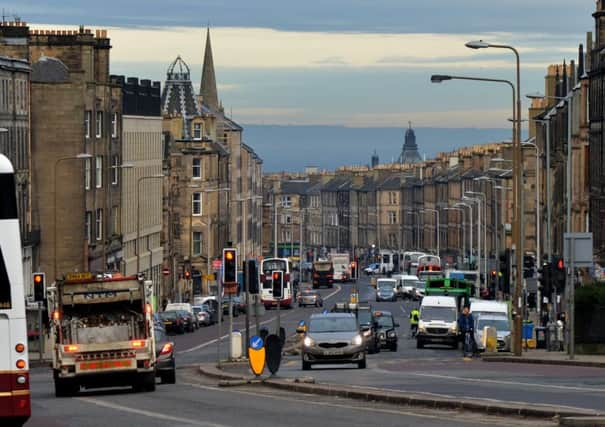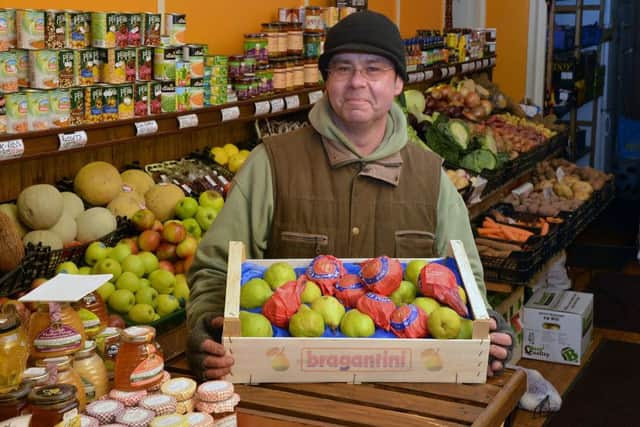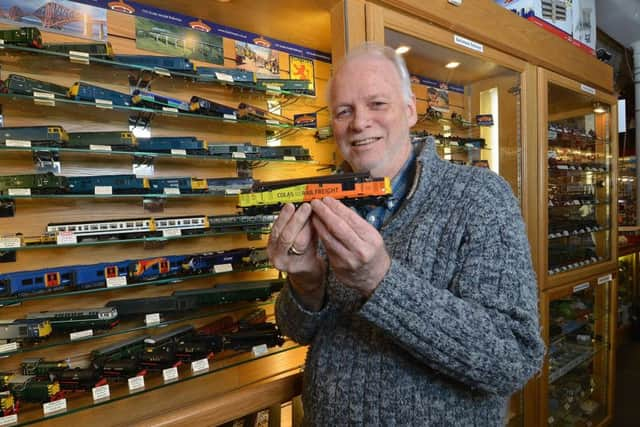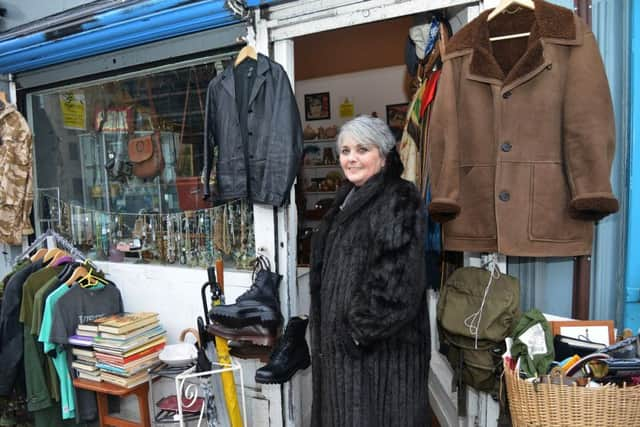Changing face of Leith: Has '˜gentrification' meant improvement?


Yet the new model army invaders of today are more likely to have top-knots than roundheads as hipsters lead the charge. The Evening News finds out what impact, good and bad, the influx is having in the Capital’s eastern melting pot.
James Welby, 48, is celebrating the 20th anniversary of his greengrocer Tattie Shaws near the top of the walk.
Advertisement
Hide AdAdvertisement
Hide Ad“It’s definitely changed,” he told us. “There are lots of foreigners now, Polish and Spanish and others, and it’s positive.


“There’s different types of cultures and nationalities – the diversity is phenomenal as opposed to when I first started in 1997.”
But not all the new arrivals are so welcome. “Lots of student accommodation gets built too with a Sainsbury’s underneath,” says James. “They’re hubs and they don’t use local amenities.
“We used to have Standard Life buildings and the DVLA test centre across the road but now it’s a youth hostel. We used to have up to 300 people come through here every day.
Advertisement
Hide AdAdvertisement
Hide Ad“They’d come and get an apple or an orange for their break and then come back to get potatoes and broccoli for their tea – it was good business.”


James says much of his new business comes from foreign diasporas not brought up on the UK’s supermarket culture – instead demanding a range of fresh produce.
And the grocer is determined to move with the times – adding chorizo and an Italian range to the Granny Smiths and seasonal veg.
Booming property prices, meanwhile, mean tenements have been typically taken over by young professionals who have little time or inclination for home cooking.
Advertisement
Hide AdAdvertisement
Hide Ad“They’re young couples working 24/7 to make ends meet to afford to live in there so they’re eating on the go,” he says, motioning to the Georgian block opposite.


And how will it look in another 20 years? “I don’t know,” laughs James. “Ocean Terminal was meant to be a terminal bringing in goods to the whole of Scotland – maybe that will happen.
“What’s hurting Leith Walk is letting all the big chains in – Costa coffee getting rid of all the small, independent coffee shops.”
James has seen independent grocers, butchers, fishmongers and newsagents close after supermarkets move in.
Advertisement
Hide AdAdvertisement
Hide Ad“It killed Dalry and Gorgie in the early 90s. They say they create jobs but when they bring a big one in, they’re knocking two or three out.”


But James is optimistic for the future, and confident customers will always want a range of produce.
“I know what people want and I know my stuff, it’s getting people in the door,” he says.
Ellen McIntosh, 52, has run the Cutting Room hair salon for 16 years. She and two staff are bustling around three ladies when we arrive.
Advertisement
Hide AdAdvertisement
Hide AdWhile Leith Walk is undeniably changing, Ellen says the most unwelcome invasion is “constant” roadworks.
“It’s a nightmare,” she says. “We had no bus stop for three months. A lot of my customers are passengers and it’s too far for them to walk.”
A lack of passing trade during works led to the independent Fairtrade coffee shop next door closing after eight years, says Ellen.


“It’s like a ghost town some days,” she adds. “You look down there and it’s just like a big runway. I hope it gets better but who knows.”
Advertisement
Hide AdAdvertisement
Hide AdCustomer and Hopetoun Street resident Myra Anderson, 76, says: “There’s been a lot of changes. People who’ve been there ten or 12 years have just sold up with property prices going up.
“Tesco has come which is quite good for me but independent shops have shut – some of its good and some not good.”
Jane Rankine, 58, of nearby Vintiques antique shop sells collectables to visitors and traders.
She slams Leith Walk’s proposed tram extension and claims last year’s roadworks lost her £10,000 in revenue.
Advertisement
Hide AdAdvertisement
Hide Ad“If everybody had a home to live in and all things being equal. If children weren’t being fed from food banks and you’d eradicated that, then fine,” she thunders.
No store has had to change with the times more than Borlands – founded in 1925 selling and fixing wirelesses. It moved into TVs and golf equipment, only to have to diversify again, into darts, after “knocked off” golf gear was sold from a car park down the road.
“Back in the 70s, they’d be queuing round the block – tungsten was so hard to get,” says Ray Withey, 62, of the switch to darts.
Ray also keeps his powder dry for the council – describing the authority as “bad for business” for scrapping car parking out front.
Advertisement
Hide AdAdvertisement
Hide AdHe adds: “Our customers would practise darts on the board in the shop but now they don’t have time because they can’t park,” says Ray.
Partner and Borlands heir, Maureen, remembers an altogether different time as a schoolgirl visiting the family store in the late 1960s.
“It was a bustling, busy shopping street,” she wistfully recalls. “People would walk up and down. You used to say if you couldn’t get it anywhere, you’d get it in Leith Walk.”
A relative newcomer to the walk is Scandinavian cafe Nordic Affär. But even in her short time, owner Alexandra Williams has had to diversify.
Advertisement
Hide AdAdvertisement
Hide AdLaunched as a deli selling breads and authentic Scandi foods in 2015, it became a cafe last year.
“There are a lot of young families moving to the area and young mothers – I’m thinking how to cater for them, what are their needs,” says Alexandra, having just put in a creche area.
“It reminds me of the south part of Stockholm which used to be a working class area and then it became really trendy and really expensive.
“I’ve seen changes,” recalls Alexandra, who moved to Leith 12 years ago. “Living and working here, I definitely think it’s the best part of town. I like that type of mixture of artists and working classes.”
Advertisement
Hide AdAdvertisement
Hide AdBob Baird’s Harburn Hobbies store can trace its Leith Walk roots back to 1938, maybe earlier.
His mum, Lena, delivered stock to the store’s original site at the Leith end of the thoroughfare on her pony and trap during the Second World War.
“Customers used to walk a mile-and-a-half from Waverley station,” recalls Bob, 70. “Everybody came in panting.”
He adds: “It’s much more niche now. You get a reputation. There’s not as many kids doing model railways compared to what it used to be like,” he adds, the last surviving of three model shops on Leith Walk.
Advertisement
Hide AdAdvertisement
Hide AdThe street has run true through the personal and professional life of Harburn regular, retired policeman and history buff Graham Dick.
His wife Susan grew up in Pilrig and the couple were wed at St Paul’s, the church on the corner of Leith Walk and Pilrig Street.
As traffic management inspector, Graham closed off Leith Walk for the King of Norway’s visit in the early 90s.
“There’s no postal address for Leith Walk and no legal name for it,” says Graham, 64. “For the traffic order, we had to go through and put down all the road names, like Elm Row, known generally as Leith Walk,” he laughs.
Advertisement
Hide AdAdvertisement
Hide AdGraham recalls fondly Fairburns, where revellers would queue around the block to buy the cheapest booze in the city ahead of Hogmanay.
“Each block would have its own community,” he says. “With a chemist, a butcher, a baker. It’s been gentrified. It was very much a working class area – now it’s middle class and very studenty.”
No single business epitomises changing times on Leith Walk than the Bier Hoose, formerly the Boundary Bar straddling the frontier between Leith and Edinburgh.
Legend has it, regulars would take advantage of Leith’s later licensing laws by leaving through the Edinburgh sidedoor, walk down the street and re-enter by the Leith door to carry on drinking.
Advertisement
Hide AdAdvertisement
Hide AdManager Nathan Ross admits some regulars were “a wee bit upset” when Bier Hoose opened, specialising in German and Belgium beers – but are being won round.
So much so, plans are afoot to reinstall the famous boundary line down the middle of the bar, which celebrates its one-year anniversary next month.
“A lot of people come in baffled and bemused,” admits assistant manager Carmen Allison, 34. “There’s a bit on our menus about our past. We didn’t want to turn away from the history – we’re celebrating it.
“People complain about gentrification but we’re moving with the times. You can see the different type of people coming in and the majority stay in Leith Walk.”
Advertisement
Hide AdAdvertisement
Hide AdAnd while hipsters may be spotted sampling the latest Bavarian tipple in steins on upturned barrel bar stools, Bier Hoose is also courting the Leith Walk of old.
“We get the Hibees in and they’re one of the best days we have,” says Carmen, of the green army. “It’s a great atmosphere and they’re a great bunch of people.”